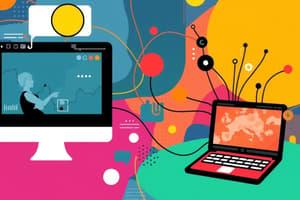Podcast
Questions and Answers
What is communication broadly defined as?
What is communication broadly defined as?
- The exchange of money
- The understanding of numbers
- The ability to read and write
- The imparting and exchanging of information or news (correct)
Which of the following is NOT a medium of communication mentioned?
Which of the following is NOT a medium of communication mentioned?
- Personal Finance (correct)
- Conversation
- Digital/Interactive
- Public Speaking
Media refers to various channels of communication and can include television and the internet.
Media refers to various channels of communication and can include television and the internet.
True (A)
What is media literacy?
What is media literacy?
Define information literacy.
Define information literacy.
Which term describes the essential skills that allow individuals to engage with media and information providers effectively?
Which term describes the essential skills that allow individuals to engage with media and information providers effectively?
The ability to use technological tools responsibly is known as ___________.
The ability to use technological tools responsibly is known as ___________.
Study Notes
Introduction to Media and Information Literacy
- Rapid technological advancements create an overwhelming influx of information easily accessible from home.
- Senior High School students must be adept in understanding and utilizing information effectively in various contexts.
- Communication, defined as the exchange of information, is fundamental in interpersonal interactions.
Communication Mediums
- Conversation: Direct, person-to-person interaction using verbal communication.
- Public Speaking: A single speaker addressing a large audience.
- Documents/Letters/Mails: Written communication in various formats, typically printed.
- Visual Art Messages: Non-verbal communication through paintings, videos, and images to convey ideas and emotions.
- Physical Medium: Tactile objects like billboards, posters, and product packaging that communicate messages.
- Digital/Interactive: Electronic means of communication like websites and apps, primarily utilizing the internet.
Media Contextualization
- Media is often equated with technology and consists of multiple channels for communication.
- Examples of media include television, radio, newspapers, and digital platforms, all facilitating information dissemination.
- Print media is one of the oldest forms and is a continuous part of human exposure to information.
Role of Media in Communication
- Communication and media are interrelated; media serves as the platform for expressing and sharing information.
- A media platform can act as both a source of information and a medium for communication, thereby enhancing understanding and interaction.
Key Concepts of Literacy
- Literacy: Involves the ability to read, write, and communicate effectively within various contexts, aiding personal and societal involvement.
- Media: Physical objects and channels that enable communication, including traditional and digital mediums.
- Media Literacy: Encompasses the skills to access, analyze, evaluate, and create media, empowering informed engagement with technologies.
- Information: A broad term representing processed data and knowledge gained from various sources, including education and experience.
- Information Literacy: The capability to recognize information needs, and locate, assess, and communicate that information with diversity in formats.
- Digital Literacy: The responsible and effective use of technology to access, manage, integrate, evaluate, create, and communicate information.
Media and Information Literacy
- Essential skills empowering individuals to interact with media and information while fostering critical thinking and lifelong learning.
- Supports active citizenship through informed engagement with media and community involvement.
Studying That Suits You
Use AI to generate personalized quizzes and flashcards to suit your learning preferences.
Related Documents
Description
This quiz tests your knowledge of media and information literacy, focusing on how to effectively understand and communicate in a technology-driven environment. As Senior High School students, you are expected to be adept at navigating the vast amounts of information available. Let's explore your skills in this essential area.




